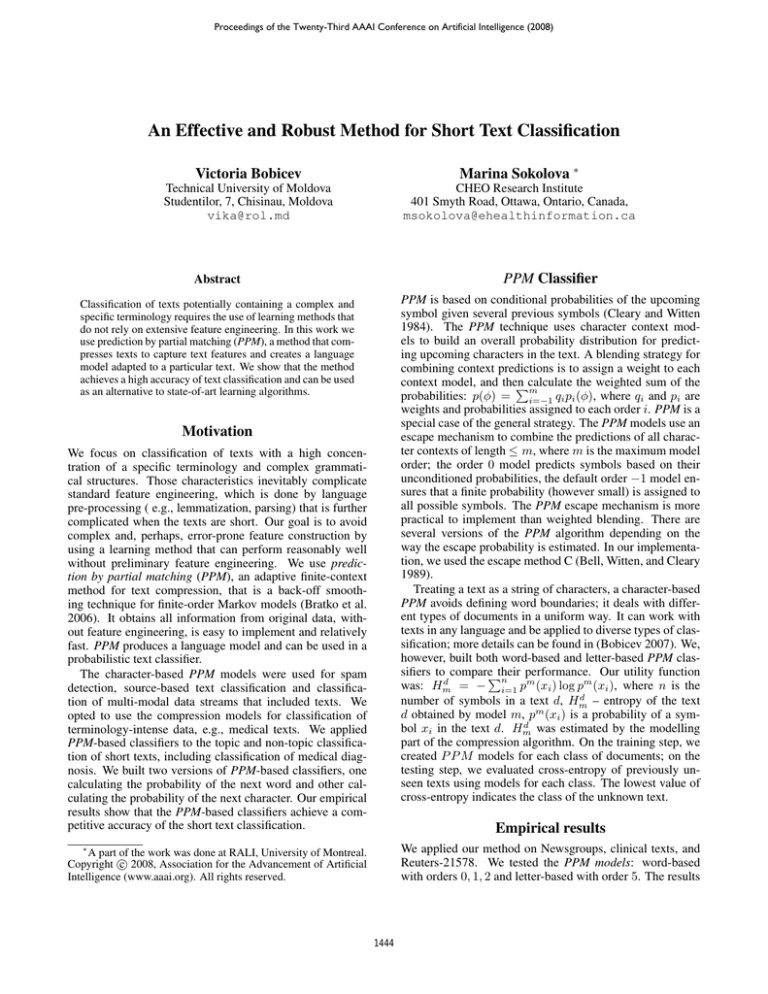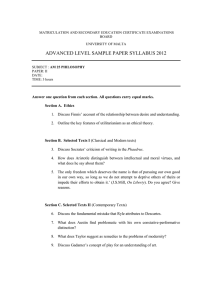
Proceedings of the Twenty-Third AAAI Conference on Artificial Intelligence (2008)
An Effective and Robust Method for Short Text Classification
Victoria Bobicev
Marina Sokolova ∗
Technical University of Moldova
Studentilor, 7, Chisinau, Moldova
vika@rol.md
CHEO Research Institute
401 Smyth Road, Ottawa, Ontario, Canada,
msokolova@ehealthinformation.ca
Abstract
PPM Classifier
Classification of texts potentially containing a complex and
specific terminology requires the use of learning methods that
do not rely on extensive feature engineering. In this work we
use prediction by partial matching (PPM), a method that compresses texts to capture text features and creates a language
model adapted to a particular text. We show that the method
achieves a high accuracy of text classification and can be used
as an alternative to state-of-art learning algorithms.
PPM is based on conditional probabilities of the upcoming
symbol given several previous symbols (Cleary and Witten
1984). The PPM technique uses character context models to build an overall probability distribution for predicting upcoming characters in the text. A blending strategy for
combining context predictions is to assign a weight to each
context model, and then
the weighted sum of the
Pcalculate
m
probabilities: p(φ) = i=−1 qi pi (φ), where qi and pi are
weights and probabilities assigned to each order i. PPM is a
special case of the general strategy. The PPM models use an
escape mechanism to combine the predictions of all character contexts of length ≤ m, where m is the maximum model
order; the order 0 model predicts symbols based on their
unconditioned probabilities, the default order −1 model ensures that a finite probability (however small) is assigned to
all possible symbols. The PPM escape mechanism is more
practical to implement than weighted blending. There are
several versions of the PPM algorithm depending on the
way the escape probability is estimated. In our implementation, we used the escape method C (Bell, Witten, and Cleary
1989).
Treating a text as a string of characters, a character-based
PPM avoids defining word boundaries; it deals with different types of documents in a uniform way. It can work with
texts in any language and be applied to diverse types of classification; more details can be found in (Bobicev 2007). We,
however, built both word-based and letter-based PPM classifiers to comparePtheir performance. Our utility function
n
d
was: Hm
= − i=1 pm (xi ) log pm (xi ), where n is the
d
number of symbols in a text d, Hm
– entropy of the text
m
d obtained by model m, p (xi ) is a probability of a symd
bol xi in the text d. Hm
was estimated by the modelling
part of the compression algorithm. On the training step, we
created P P M models for each class of documents; on the
testing step, we evaluated cross-entropy of previously unseen texts using models for each class. The lowest value of
cross-entropy indicates the class of the unknown text.
Motivation
We focus on classification of texts with a high concentration of a specific terminology and complex grammatical structures. Those characteristics inevitably complicate
standard feature engineering, which is done by language
pre-processing ( e.g., lemmatization, parsing) that is further
complicated when the texts are short. Our goal is to avoid
complex and, perhaps, error-prone feature construction by
using a learning method that can perform reasonably well
without preliminary feature engineering. We use prediction by partial matching (PPM), an adaptive finite-context
method for text compression, that is a back-off smoothing technique for finite-order Markov models (Bratko et al.
2006). It obtains all information from original data, without feature engineering, is easy to implement and relatively
fast. PPM produces a language model and can be used in a
probabilistic text classifier.
The character-based PPM models were used for spam
detection, source-based text classification and classification of multi-modal data streams that included texts. We
opted to use the compression models for classification of
terminology-intense data, e.g., medical texts. We applied
PPM-based classifiers to the topic and non-topic classification of short texts, including classification of medical diagnosis. We built two versions of PPM-based classifiers, one
calculating the probability of the next word and other calculating the probability of the next character. Our empirical
results show that the PPM-based classifiers achieve a competitive accuracy of the short text classification.
Empirical results
We applied our method on Newsgroups, clinical texts, and
Reuters-21578. We tested the PPM models: word-based
with orders 0, 1, 2 and letter-based with order 5. The results
∗
A part of the work was done at RALI, University of Montreal.
c 2008, Association for the Advancement of Artificial
Copyright °
Intelligence (www.aaai.org). All rights reserved.
1444
Compression
word-based
letter-based
order
1
5
Prec
0.63
0.96
Recall
0.91
0.84
F-score
0.77
0.90
AUC
0.93
0.98
compared several methods, e.g., SVM, Naive Bayes. Our
results are close to the best results obtained by SVM; see
Table 2. We did not compare directly our results to those of
(Debole and Sebastiani 2005) because the test data splits do
not completely match. The data were split on sets of 15 categories with the highest number of positive training examples
(Reuters(15)), 96 categories with at least three positive examples (Reuters(96)), 105 categories with at least two positive examples (Reuters(105)). For Reuters(15), texts with
only one label were selected from the whole test set. Consequently, 3 categories did not have test texts, thus, we calculated results for the remaining 12 categories. We resolved
the multi-labelling problem as in experiments with medical
texts.
For Newsgroups, we report some letter combinations and
the words they appear in: ent, ati (patients, treatment); her
(therapy); res (research, result); ect (infection, detect, effect) are frequent in medical texts and sparse otherwise; ver
(government, university); thi (thing, think); sta (state, standard, started); tic (article, politics); uld (would, should,
could) are sparse in medical texts and frequent otherwise.
Table 1: Classification of medical texts from Newsgroups.
Classification of clinical texts
Compression order Prec Recall
word-based
1
0.33
0.45
letter-based
5
0.36
0.42
Classification of Reuters
Compression order Prec Recall
Reuters(15)
word-based
1
0.75
0.70
letter-based
5
0.65
0.83
Reuters(96)
word-based
1
0.61
0.68
letter-based
5
0.72
0.57
Reuters(105)
word-based
1
0.77
0.62
letter-based
5
0.78
0.63
F-score
0.38
0.39
F-score
0.73
0.73
0.64
0.64
0.68
0.69
Table 2: The macroaveraging results for clinical texts and Reuters.
Discussion
We have presented a comparative study of classification of
short text collections, a challenging text classification task.
We applied PPM-based classifiers that do not require data
pre-processing or feature engineering. The results of the
experiments showed that PPM-based compression provides
a reliable accuracy of text classification. The letter-based
method performed slightly better than the word-based methods. A possible explanation is the quality of texts: texts
are noisy and contain errors of different types that affect
the word-based methods. Letter-based methods avoid these
problems and, in general, better capture the characteristics of
the text. It should be mentioned that the letter-based model
is more compact and faster to build. For future work, we
want to concentrate on P P M applications for multi-class
classification. Another promising direction can be to test
the method on other multi-labelled texts, especially medical
texts, and explore different ways of multiple classification
(several labels assigned) of unknown documents.
of the word-based model with order 0 were unexpectedly
much lower than those of other word-based models; we decided to skip it in further experiments. The results of the
word-based model with order 1 were very close to those of
order 2. We attribute the similarity to a short length of texts.
We used the complete Newsgroup data, 19, 974 texts that
evenly belong to 20 topic categories. We report results for
medical texts, classified among 20 given classes. Our results on Newsgroups are competitive with those of (Frank
and Bouckaert 2006) that use Naive Bayes; see Table 1.
For medical diagnosis classification, we used 978 samples of chest x-ray and renal procedures from Medical NLP
Challenge 2007 1 . The texts contained 15 − 20 words, e.g.
CLINICAL HISTORY: Cough, congestion, fever. IMPRESSION: Increased markings with subtle patchy disease right
upper lobe. Atelectasis versus pneumonia. Those texts had
multiple labels (ICD-9-CM codes). The labels formed 94
distinct combinations, e.g., the combination 780.6, 786.2.
33 of these combinations labelled only one example, 27 –
two examples. To solve the multi-labelling problem, we
normalized entropies of all texts for each category and assigned texts to categories for which its entropy was lower
than the mean. For each text, the number of assigned categories was restricted to 3; see Table 2. Here too, the letterbased model performed better. The results are reliable for
multi-class classification of short texts.
On Reuters-21578 corpus, we applied the Modified Apte
split to compare our results with those of (Debole and Sebastiani 2005). We considered that experiments on the same
three subsets of Reuters better demonstrate abilities of the
method, including on the difficult subset with a number of
articles with sparse labels. Debole and Sebastiani (2005)
References
Bell, T.; Witten, I.; and Cleary, J. 1989. Modeling for text compression. ACM Comput. Surv. 21(4):557–591.
Bobicev, V. 2007. Comparison of word-based and letter-based
text classification. In Proceedings of RANLP’07, 76–80.
Bratko, A.; Cormack, G. V.; Filipič, B.; Lynam, T. R.; and Zupan,
B. 2006. Spam filtering using statistical data compression models.
Journal of Machine Learning Research 7:2673–2698.
Cleary, J., and Witten, I. 1984. Data compression using adaptive coding and partial string matching. IEEE Trans. Commun.
32(4):396–402.
Debole, F., and Sebastiani, F. 2005. An analysis of the relative
hardness of reuters-21578 subsetsg. Journal of the American Society for Information Science and Technology 56(6):584–596.
Frank, E., and Bouckaert, R. 2006. Naive bayes for text classication with unbalanced classes. In Proceedings of PKDD 2006,
503–510.
1
The
data
were
provided
by
Computational
Medicine
Centre,
Cincinnati
Children’s
Hospital,
http://www.computationalmedicine.org/challenge
1445





